Abstract
Experiments were performed on awake human subjects in which single nerve fibre activity was recorded in the lateral peroneal nerve using tungsten micro-electrodes as described by Hagbarth & Vallbo (1967, 1968a). The discharge of twelve single efferent fibres innervating the tibialis anterior muscle (t.a.) or the extensor digitorum longus muscle (e.d.l.) was recorded. On the basis of their functional activity, six fibres were identified as skeletomotor and six as fusimotor fibres. Skeletomotor fibres, which were completely silent in relaxed subjects, discharged when subjects performed voluntary isometric or isotonic contractions, they also fired during Jendrassik's manoeuvre and tonic vibration reflex (t.v.r.) induced by mechanical vibration applied to the distal muscle tendon. Units considered as fusimotor fibres were generally spontaneously active with some fluctuation in the discharge frequency. Various tests used to identify afferent fibres elicited no response of these fibres (nor of the skeletomotor fibres). Efferent fibres were considered as fusimotor because their discharges were uncorrelated with any activation of extrafusal muscle fibres. Several means were used to detect activation of extrafusal fibres: surface electromyogram (e.m.g.) electrodes, tungsten electrodes deeply implanted in the muscle and especially the use of a high-sensitivity tension transducer (0 X 1 mN) placed on muscle tendons. The activity in fusimotor fibres could be either elicited or modulated under the following conditions: clenching of the fists, pinna twisting, mental computation, voluntary isometric contraction, passive phasic stretch of the muscle, environmental disturbances, subject laughing, the sound of hand clapping, and subject listening to manoeuvre instructions. Moreover, during spontaneous fusimotor fibre activity the subject was able to voluntarily stop the unit discharge. The results are compared to those obtained in animal studies and discussed with reference to the notion of alpha-gamma linkage, static and dynamic gamma-motoneurone activities, and to other available data concerning the effects of various stimulations on muscle spindle afferent activities in man.
Full text
PDF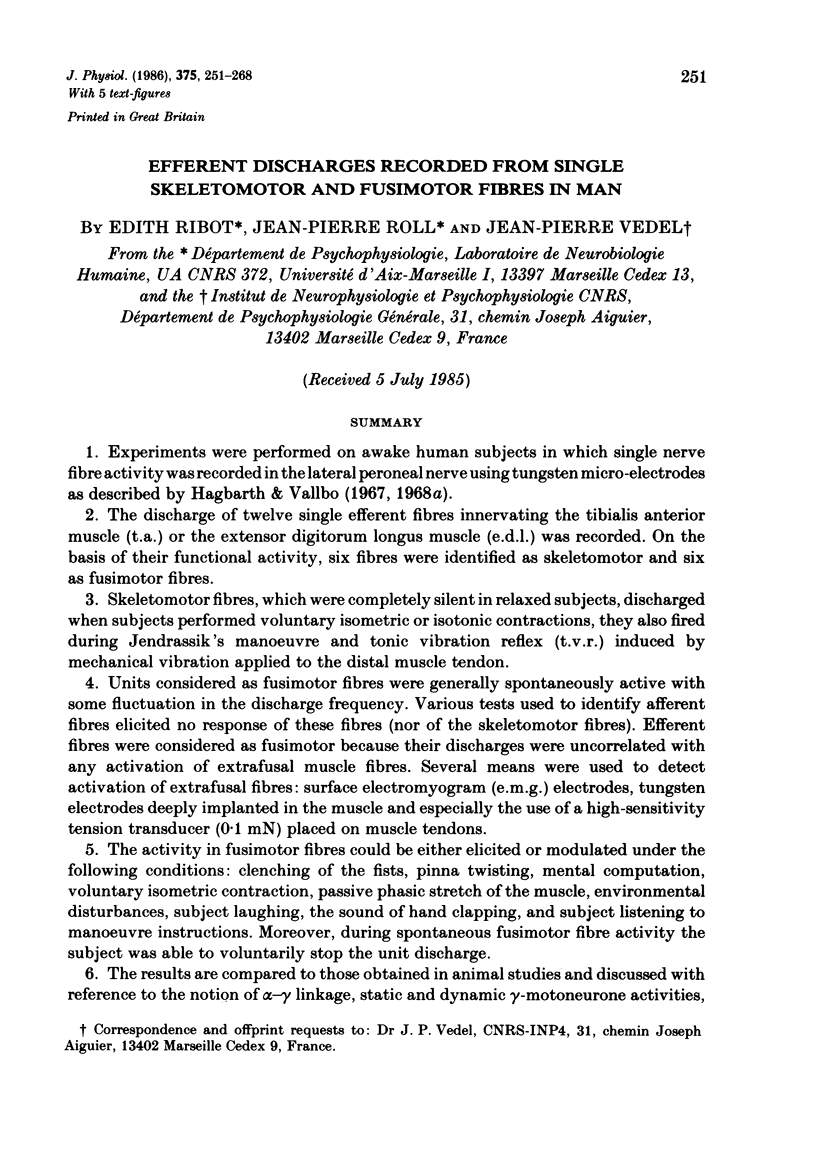
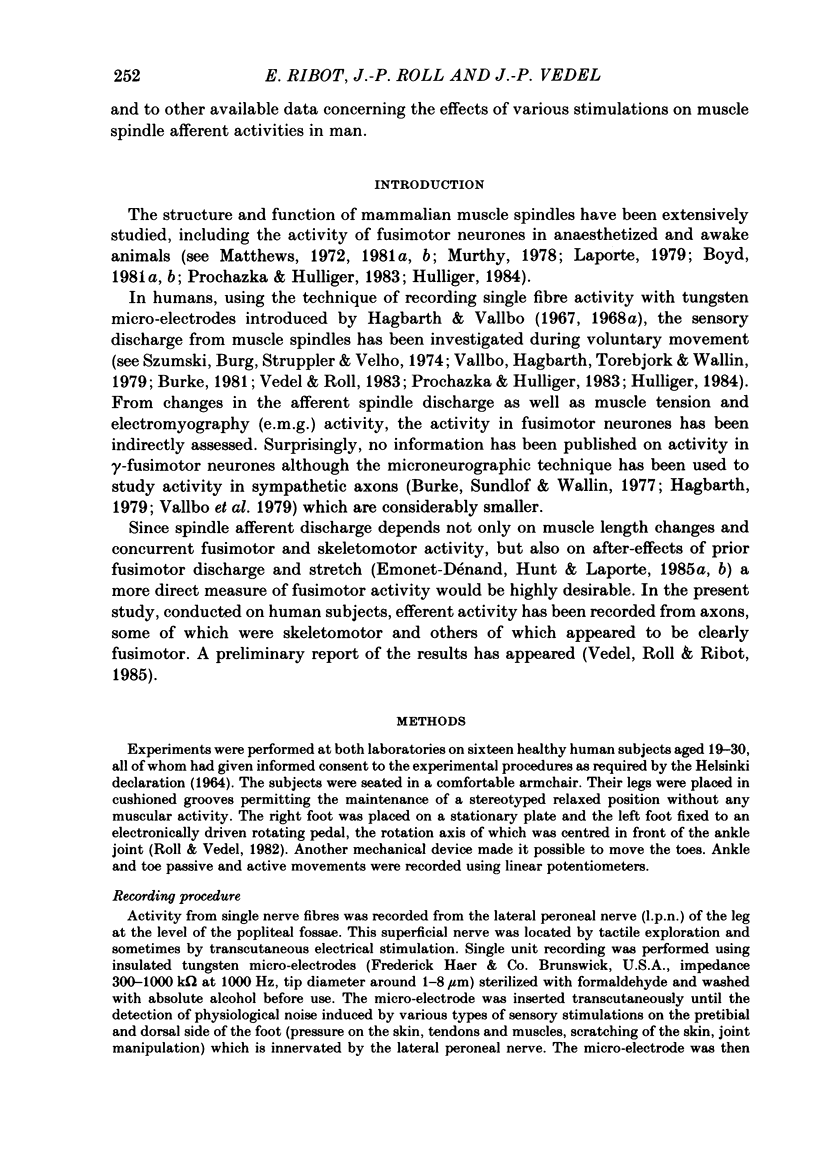
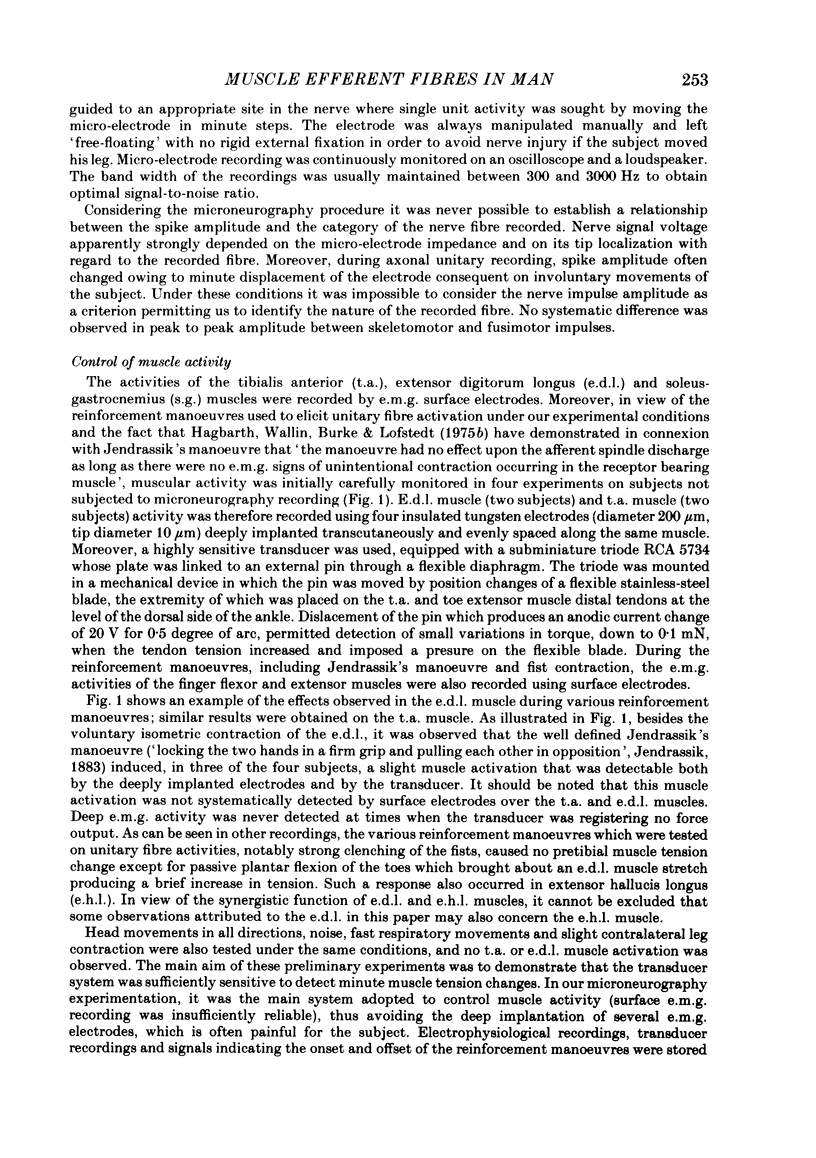
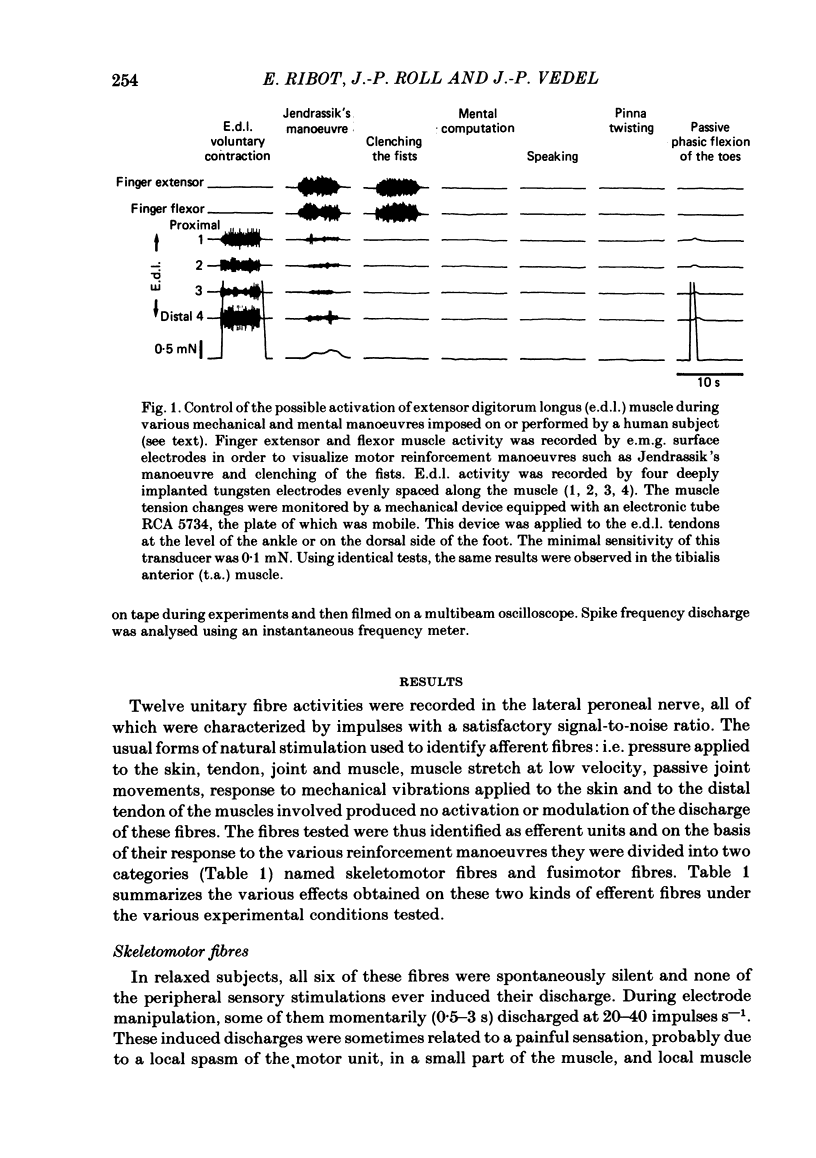
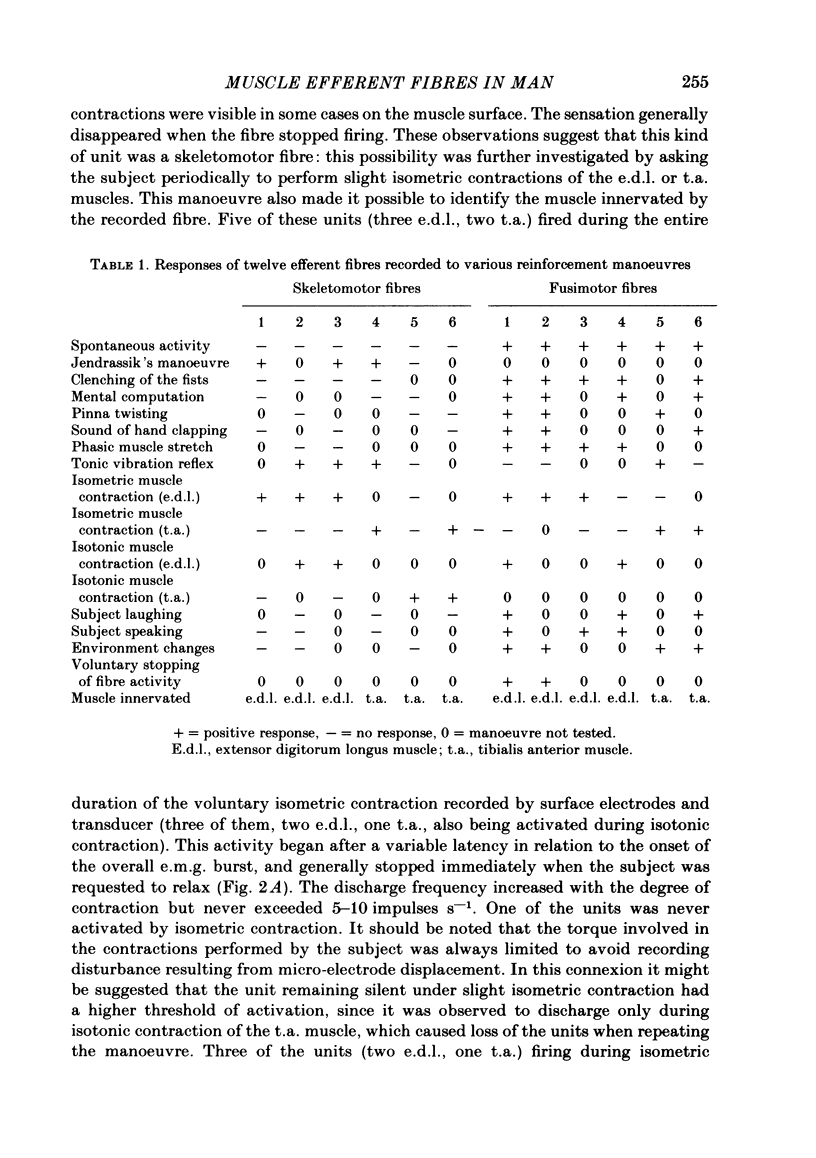
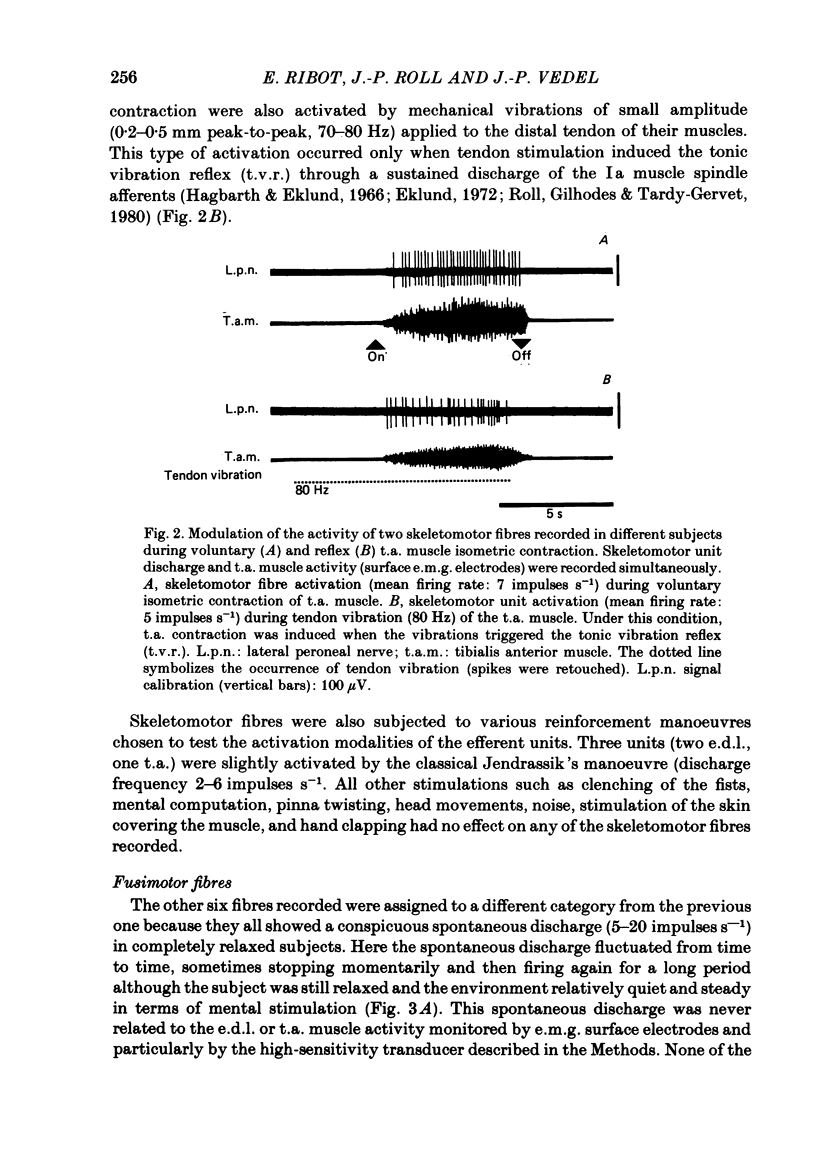
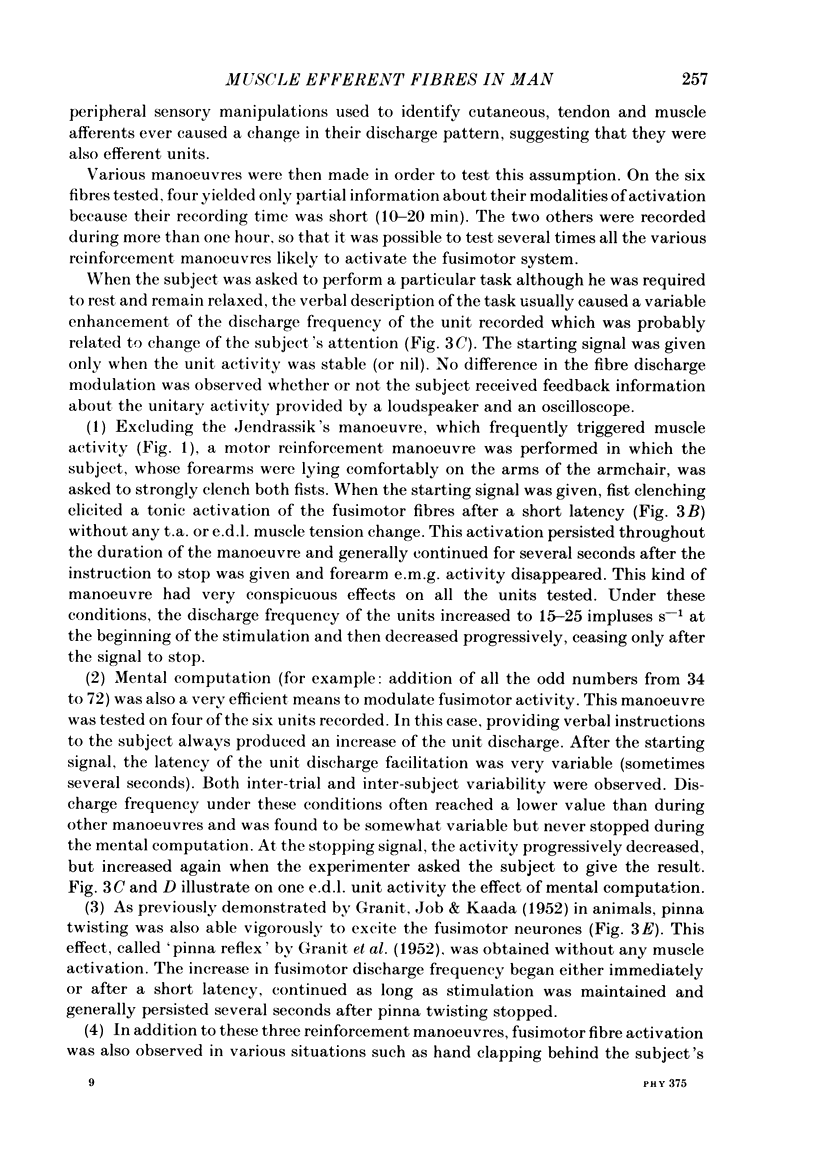
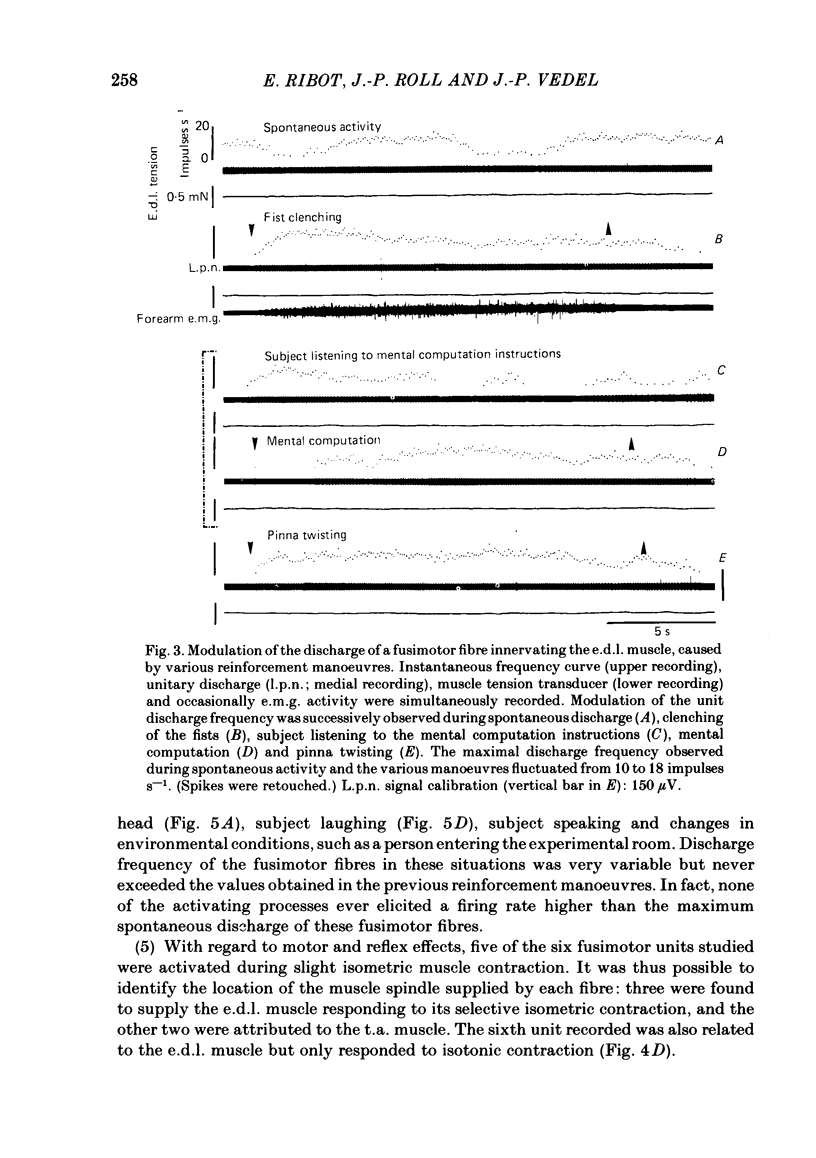
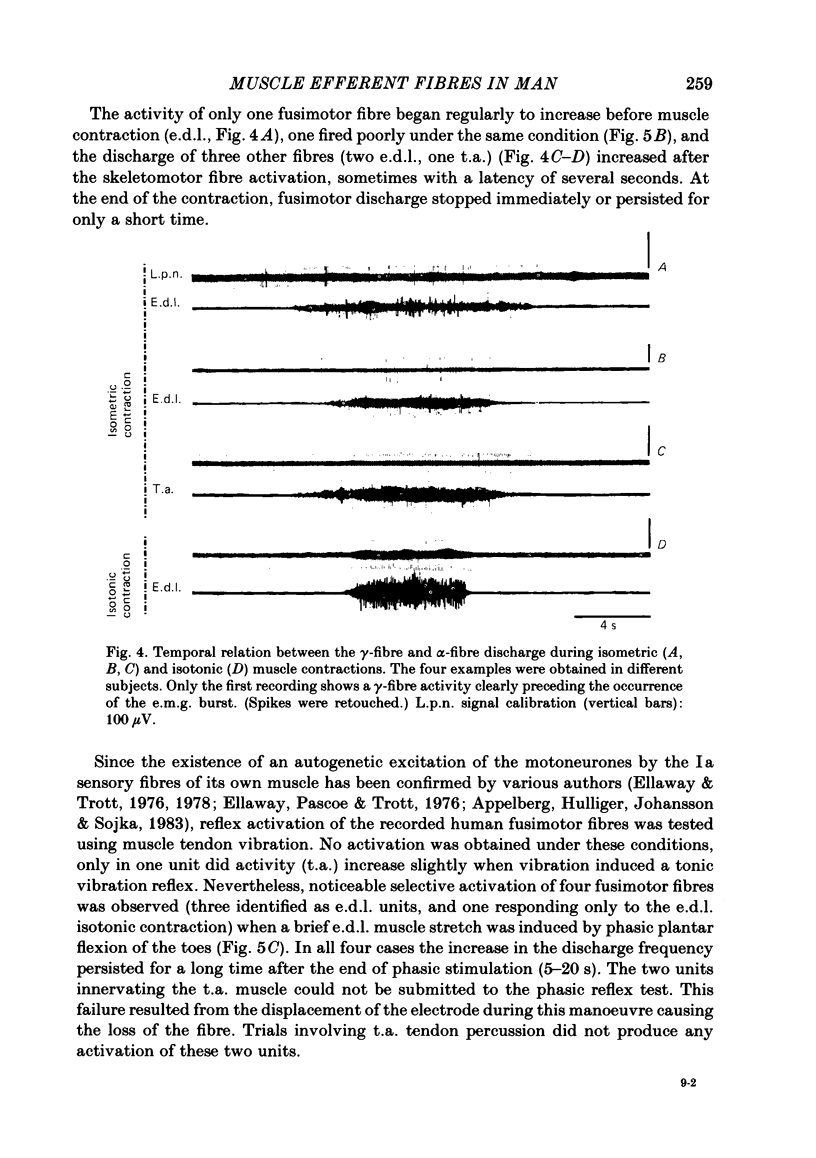
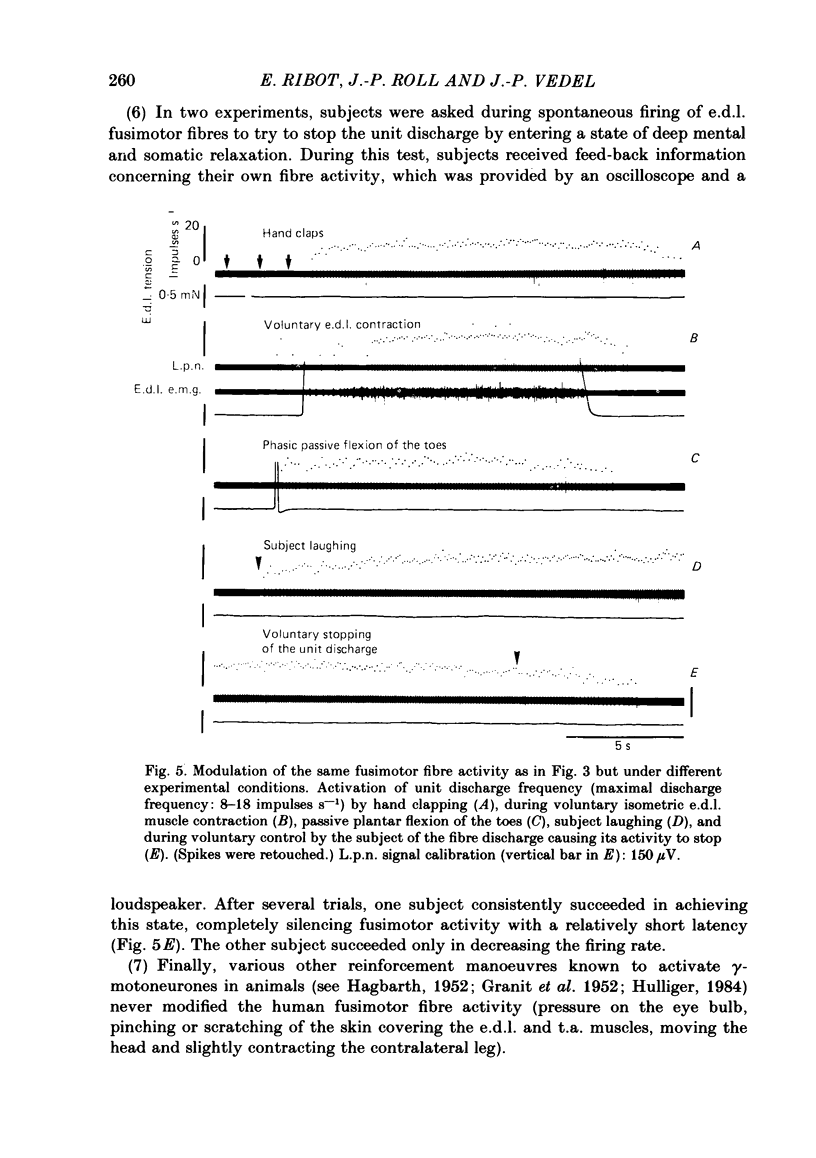
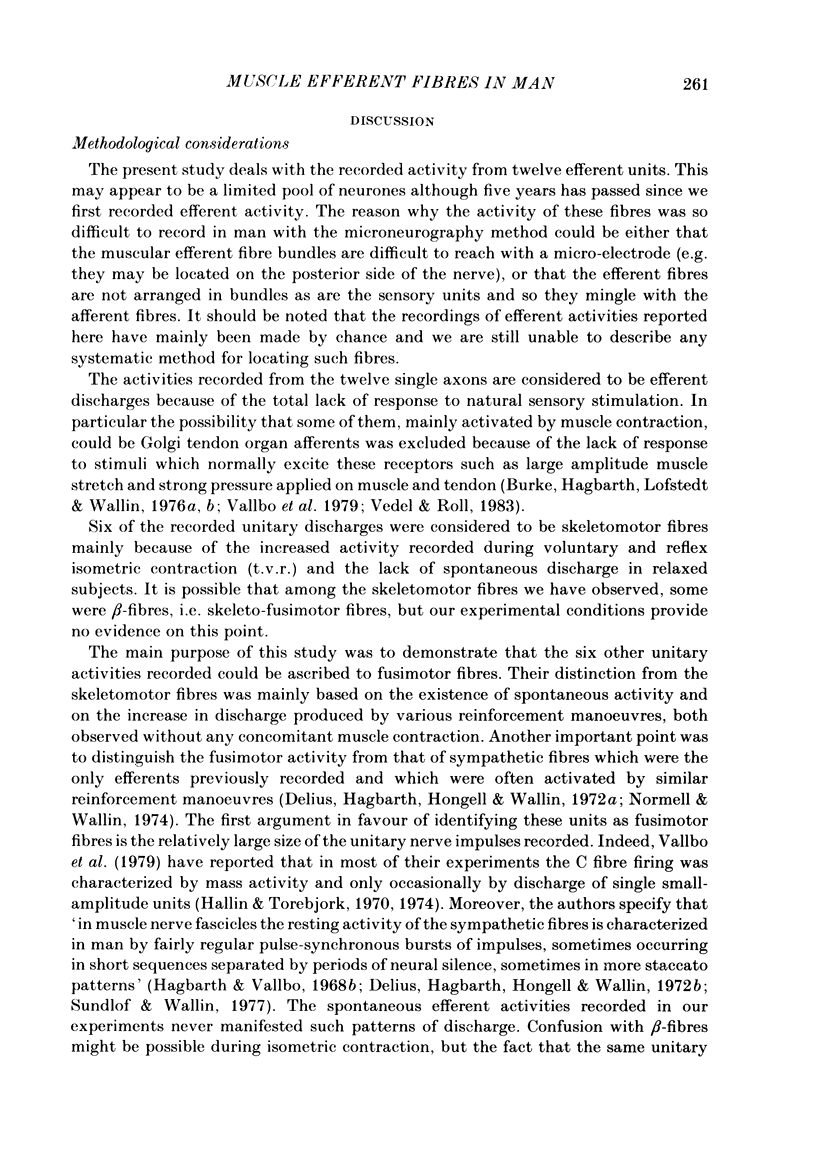
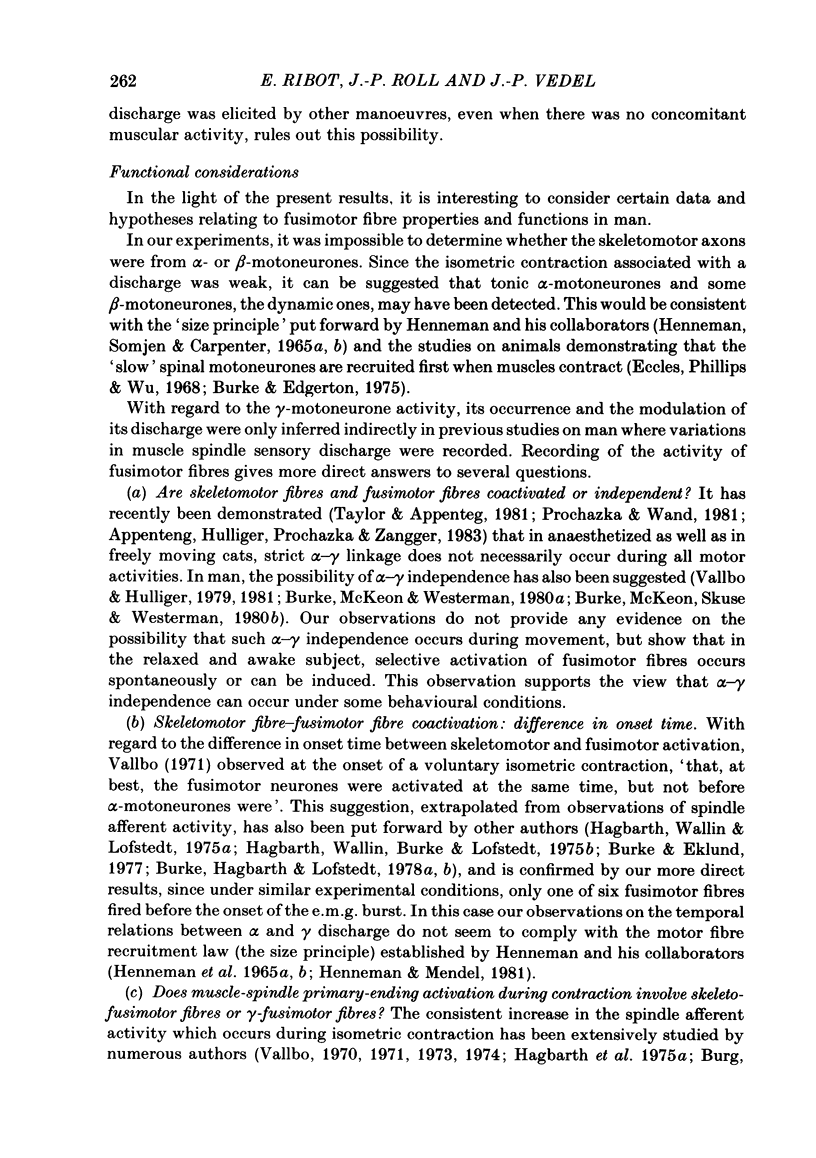
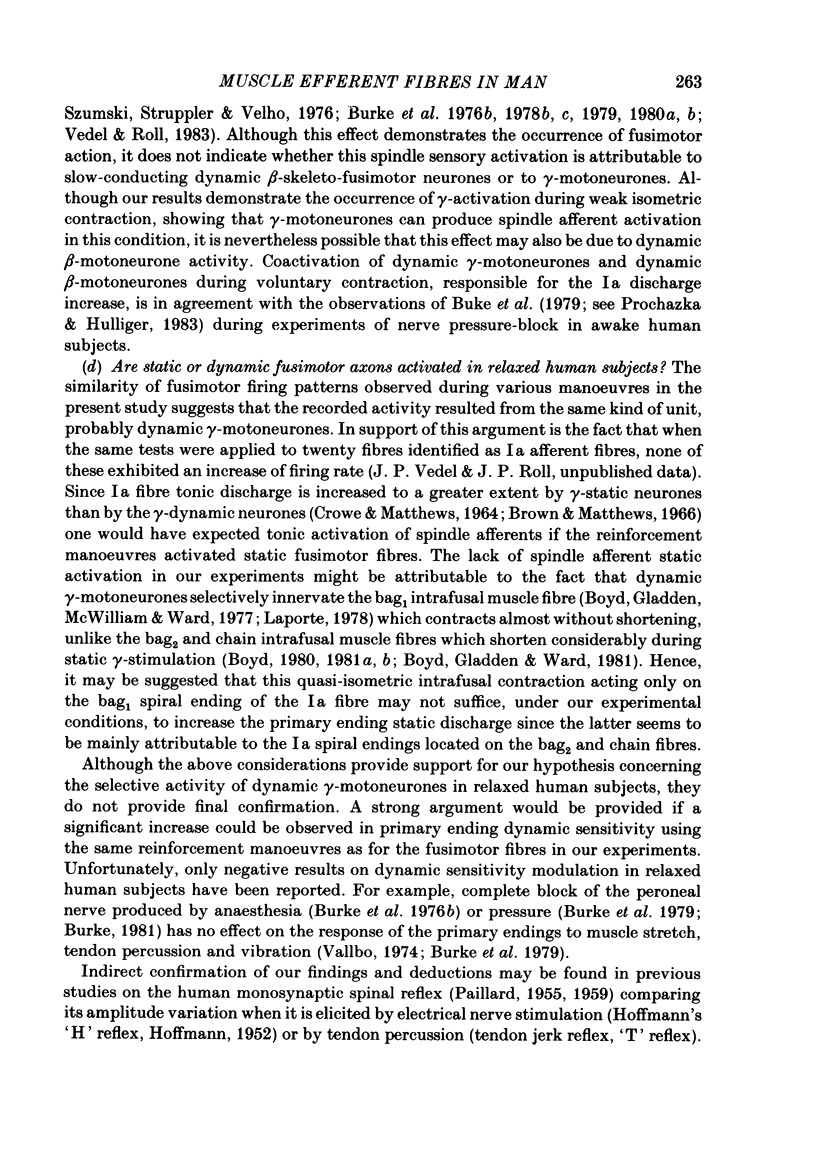
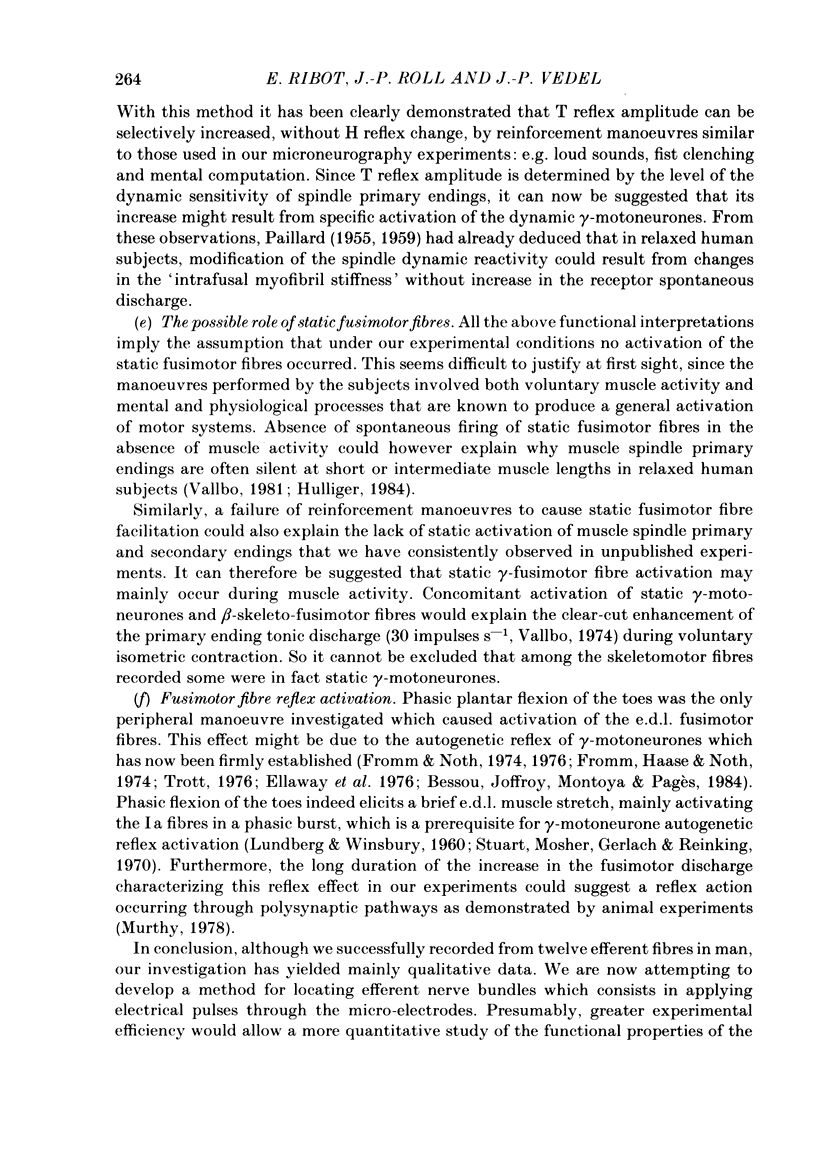
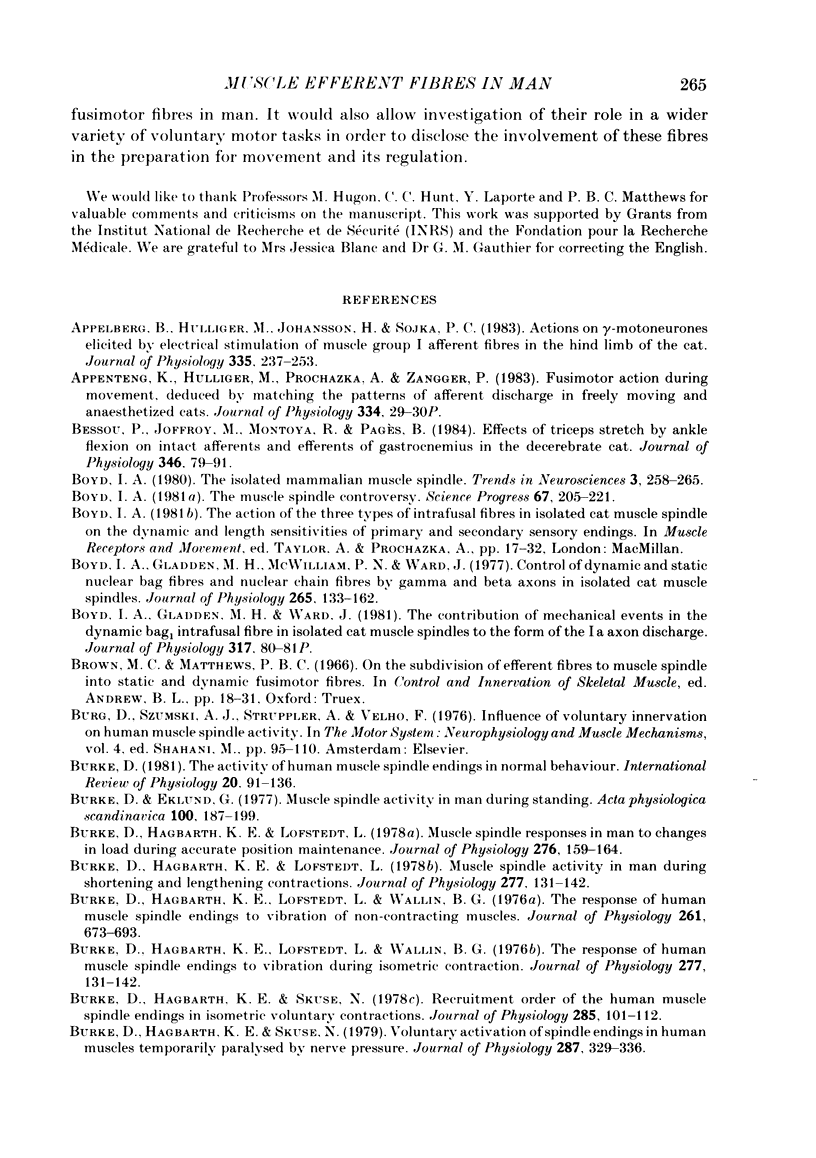
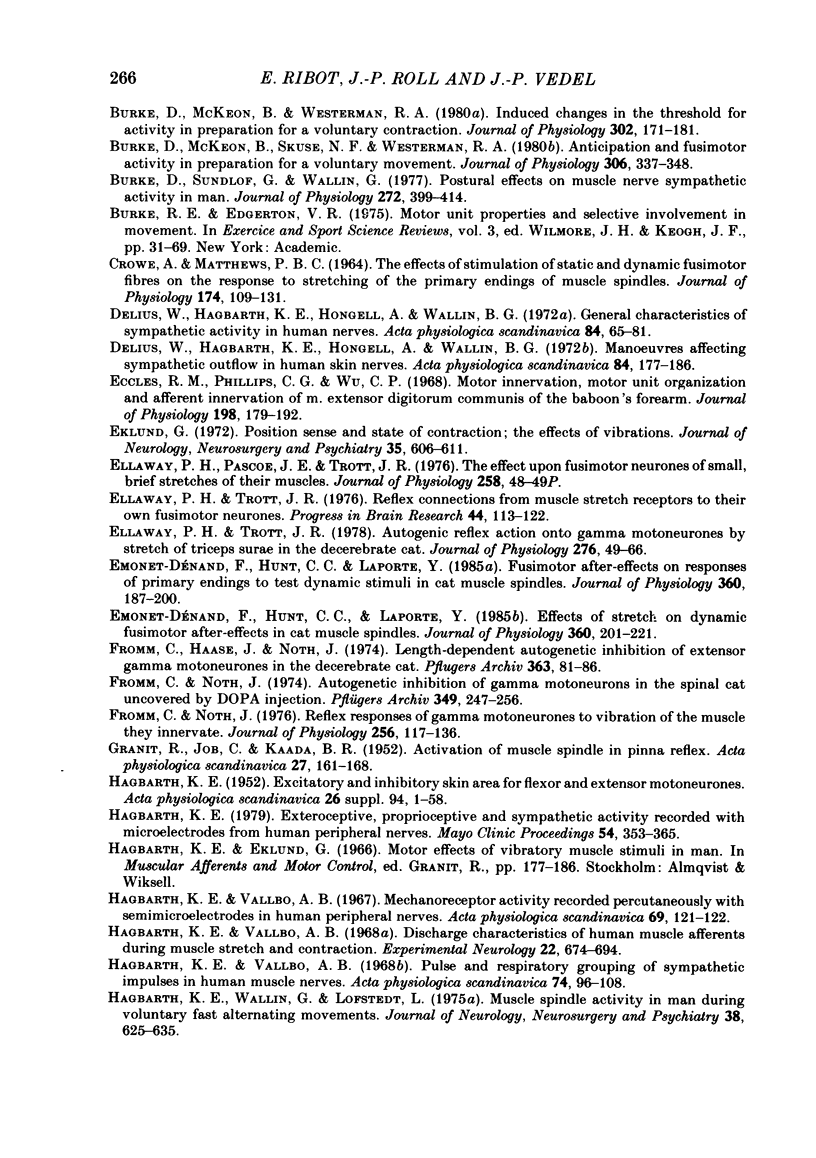
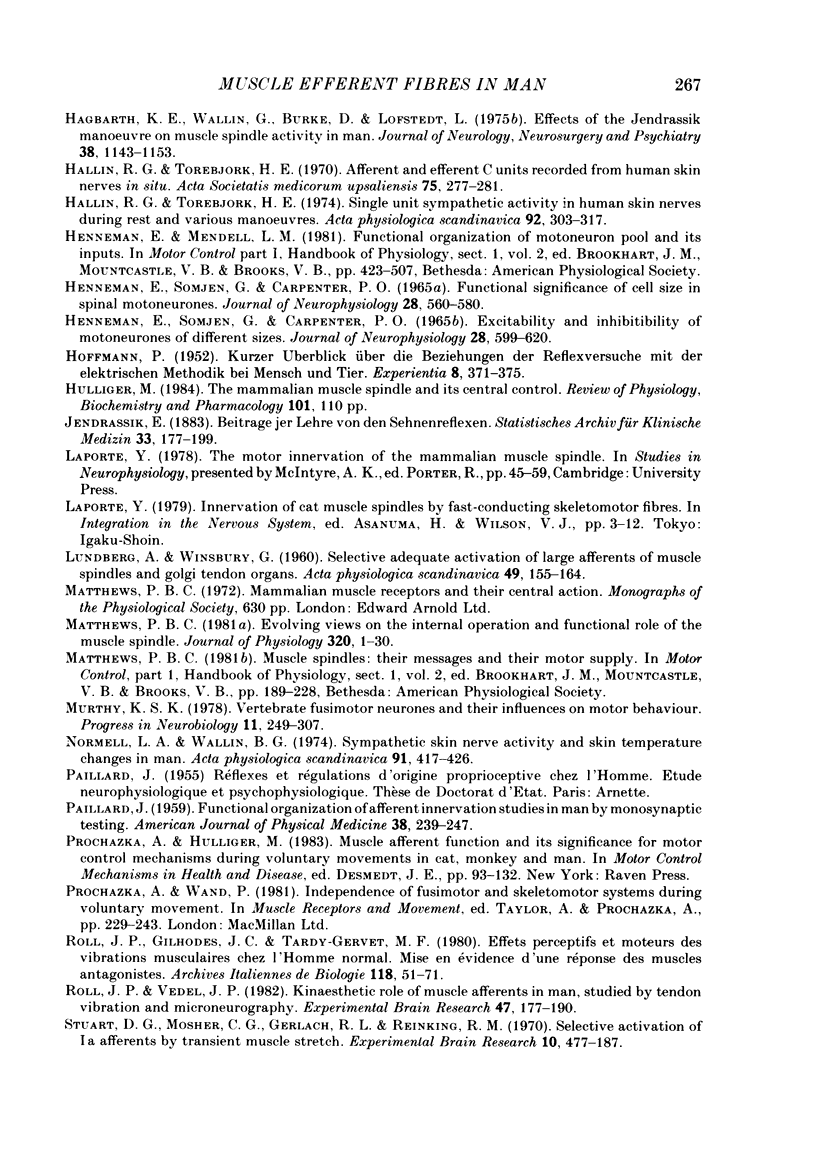
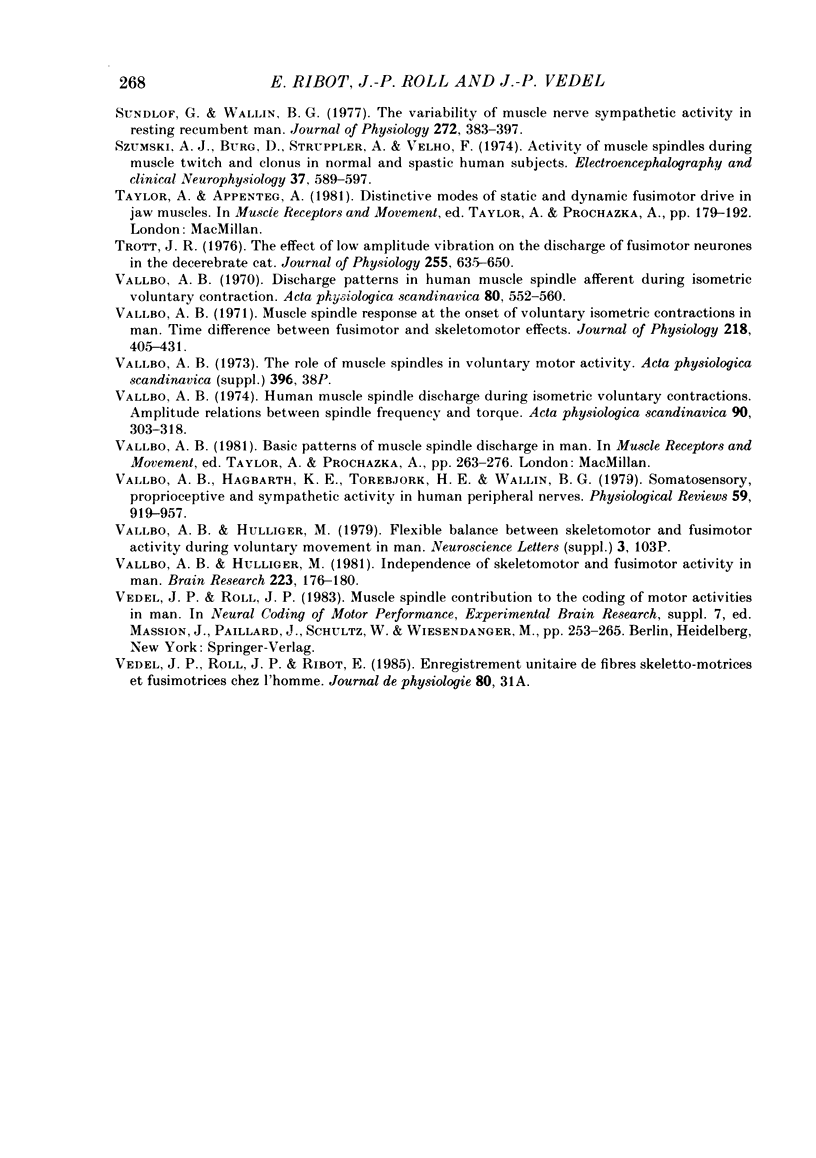
Selected References
These references are in PubMed. This may not be the complete list of references from this article.
- Appelberg B., Hulliger M., Johansson H., Sojka P. Actions on gamma-motoneurones elicited by electrical stimulation of group I muscle afferent fibres in the hind limb of the cat. J Physiol. 1983 Feb;335:237–253. doi: 10.1113/jphysiol.1983.sp014531. [DOI] [PMC free article] [PubMed] [Google Scholar]
- Boyd I. A., Gladden M. H., McWilliam P. N., Ward J. Control of dynamic and static nuclear bag fibres and nuclear chain fibres by gamma and beta axons in isolated cat muscle spindels. J Physiol. 1977 Feb;265(1):133–162. doi: 10.1113/jphysiol.1977.sp011709. [DOI] [PMC free article] [PubMed] [Google Scholar]
- Boyd I. A. The muscle spindle controversy. Sci Prog. 1981 Summer;67(266):205–221. [PubMed] [Google Scholar]
- Burke D., Eklund G. Muscle spindle activity in man during standing. Acta Physiol Scand. 1977 Jun;100(2):187–199. doi: 10.1111/j.1748-1716.1977.tb05936.x. [DOI] [PubMed] [Google Scholar]
- Burke D., Hagbarth K. E., Löfstedt L. Muscle spindle activity in man during shortening and lengthening contractions. J Physiol. 1978 Apr;277:131–142. doi: 10.1113/jphysiol.1978.sp012265. [DOI] [PMC free article] [PubMed] [Google Scholar]
- Burke D., Hagbarth K. E., Löfstedt L. Muscle spindle activity in man during shortening and lengthening contractions. J Physiol. 1978 Apr;277:131–142. doi: 10.1113/jphysiol.1978.sp012265. [DOI] [PMC free article] [PubMed] [Google Scholar]
- Burke D., Hagbarth K. E., Löfstedt L. Muscle spindle responses in man to changes in load during accurate position maintenance. J Physiol. 1978 Mar;276:159–164. doi: 10.1113/jphysiol.1978.sp012225. [DOI] [PMC free article] [PubMed] [Google Scholar]
- Burke D., Hagbarth K. E., Löfstedt L., Wallin B. G. The responses of human muscle spindle endings to vibration of non-contracting muscles. J Physiol. 1976 Oct;261(3):673–693. doi: 10.1113/jphysiol.1976.sp011580. [DOI] [PMC free article] [PubMed] [Google Scholar]
- Burke D., Hagbarth K. E., Skuse N. F. Recruitment order of human spindle endings in isometric voluntary contractions. J Physiol. 1978 Dec;285:101–112. doi: 10.1113/jphysiol.1978.sp012560. [DOI] [PMC free article] [PubMed] [Google Scholar]
- Burke D., Hagbarth K. E., Skuse N. F. Voluntary activation of spindle endings in human muscles temporarily paralysed by nerve pressure. J Physiol. 1979 Feb;287:329–336. doi: 10.1113/jphysiol.1979.sp012662. [DOI] [PMC free article] [PubMed] [Google Scholar]
- Burke D., McKeon B., Skuse N. F., Westerman R. A. Anticipation and fusimotor activity in preparation for a voluntary contraction. J Physiol. 1980 Sep;306:337–348. doi: 10.1113/jphysiol.1980.sp013400. [DOI] [PMC free article] [PubMed] [Google Scholar]
- Burke D., McKeon B., Westerman R. A. Induced changes in the thresholds for voluntary activation of human spindle endings. J Physiol. 1980 May;302:171–181. doi: 10.1113/jphysiol.1980.sp013236. [DOI] [PMC free article] [PubMed] [Google Scholar]
- Burke D., Sundlöf G., Wallin G. Postural effects on muscle nerve sympathetic activity in man. J Physiol. 1977 Nov;272(2):399–414. doi: 10.1113/jphysiol.1977.sp012051. [DOI] [PMC free article] [PubMed] [Google Scholar]
- Burke D. The activity of human muscle spindle endings in normal motor behavior. Int Rev Physiol. 1981;25:91–126. [PubMed] [Google Scholar]
- CROWE A., MATTHEWS P. B. THE EFFECTS OF STIMULATION OF STATIC AND DYNAMIC FUSIMOTOR FIBRES ON THE RESPONSE TO STRETCHING OF THE PRIMARY ENDINGS OF MUSCLE SPINDLES. J Physiol. 1964 Oct;174:109–131. doi: 10.1113/jphysiol.1964.sp007476. [DOI] [PMC free article] [PubMed] [Google Scholar]
- Delius W., Hagbarth K. E., Hongell A., Wallin B. G. General characteristics of sympathetic activity in human muscle nerves. Acta Physiol Scand. 1972 Jan;84(1):65–81. doi: 10.1111/j.1748-1716.1972.tb05158.x. [DOI] [PubMed] [Google Scholar]
- Delius W., Hagbarth K. E., Hongell A., Wallin B. G. Manoeuvres affecting sympathetic outflow in human skin nerves. Acta Physiol Scand. 1972 Feb;84(2):177–186. doi: 10.1111/j.1748-1716.1972.tb05168.x. [DOI] [PubMed] [Google Scholar]
- Eccles R. M., Phillips C. G., Chien-Ping W. Motor innervation, motor unit organization and afferent innervation of m. extensor digitorum communis of the baboon's forearm. J Physiol. 1968 Sep;198(1):179–192. doi: 10.1113/jphysiol.1968.sp008600. [DOI] [PMC free article] [PubMed] [Google Scholar]
- Ellaway P. H., Pascoe J. E., Trott J. R. Proceedings: The effect upon fusimotor neurones of small, brief stretches of their muscles. J Physiol. 1976 Jun;258(2):48P–49P. [PubMed] [Google Scholar]
- Ellaway P. H., Trott J. R. Autogenetic reflex action on to gamma motoneurones by stretch of triceps surae in the decerebrated cat. J Physiol. 1978 Mar;276:49–66. doi: 10.1113/jphysiol.1978.sp012219. [DOI] [PMC free article] [PubMed] [Google Scholar]
- Ellaway P. H., Trott J. R. Reflex connections form muscle stretch receptors to their own fusimotor neurones. Prog Brain Res. 1976;44:113–122. doi: 10.1016/S0079-6123(08)60727-X. [DOI] [PubMed] [Google Scholar]
- Emonet-Dénand F., Hunt C. C., Laporte Y. Effects of stretch on dynamic fusimotor after-effects in cat muscle spindles. J Physiol. 1985 Mar;360:201–213. doi: 10.1113/jphysiol.1985.sp015612. [DOI] [PMC free article] [PubMed] [Google Scholar]
- Emonet-Dénand F., Hunt C. C., Laporte Y. Fusimotor after-effects on responses of primary endings to test dynamic stimuli in cat muscle spindles. J Physiol. 1985 Mar;360:187–200. doi: 10.1113/jphysiol.1985.sp015611. [DOI] [PMC free article] [PubMed] [Google Scholar]
- Fromm C., Noth J. Autogenetic inhibition of gamma-motoneurons in the spinal cat uncovered by Dopa injection. Pflugers Arch. 1974 Jul 9;349(3):247–256. doi: 10.1007/BF00592452. [DOI] [PubMed] [Google Scholar]
- Fromm C., Noth J. Reflex responses of gamma motoneurones to vibration of the muscle they innervate. J Physiol. 1976 Mar;256(1):117–136. doi: 10.1113/jphysiol.1976.sp011315. [DOI] [PMC free article] [PubMed] [Google Scholar]
- Fromm C., Noth J., Thilmann A. Inhibition of extensor gamma motoneurons by anatagonistic primary and secondary spindle afferents. Pflugers Arch. 1976 May 6;363(1):81–86. doi: 10.1007/BF00587406. [DOI] [PubMed] [Google Scholar]
- GRANIT R., JOB C., KAADA B. R. Activation of muscle spindles in pinna reflex. Acta Physiol Scand. 1952;27(2-3):161–168. doi: 10.1111/j.1748-1716.1953.tb00931.x. [DOI] [PubMed] [Google Scholar]
- HAGBARTH K. E. Excitatory and inhibitory skin areas for flexor and extensor motoneurons. Acta Physiol Scand Suppl. 1952;26(94):1–58. [PubMed] [Google Scholar]
- HENNEMAN E., SOMJEN G., CARPENTER D. O. FUNCTIONAL SIGNIFICANCE OF CELL SIZE IN SPINAL MOTONEURONS. J Neurophysiol. 1965 May;28:560–580. doi: 10.1152/jn.1965.28.3.560. [DOI] [PubMed] [Google Scholar]
- HOFFMANN P. Kurzer überblick über die Beziehungen der Reflexversuche mit der elektrischen Methodik bei Mensch und Tier. Experientia. 1952 Oct 15;8(10):371–375. doi: 10.1007/BF02176190. [DOI] [PubMed] [Google Scholar]
- Hagbarth K. E. Exteroceptive, proprioceptive, and sympathetic activity recorded with microelectrodes from human peripheral nerves. Mayo Clin Proc. 1979 Jun;54(6):353–365. [PubMed] [Google Scholar]
- Hagbarth K. E., Vallbo A. B. Discharge characteristics of human muscle afferents during muscle stretch and contraction. Exp Neurol. 1968 Dec;22(4):674–694. doi: 10.1016/0014-4886(68)90156-8. [DOI] [PubMed] [Google Scholar]
- Hagbarth K. E., Vallbo A. B. Mechanoreceptor activity recorded percutaneously with semi-microelectrodes in human peripheral nerves. Acta Physiol Scand. 1967 Jan-Feb;69(1):121–122. doi: 10.1111/j.1748-1716.1967.tb03498.x. [DOI] [PubMed] [Google Scholar]
- Hagbarth K. E., Vallbo A. B. Pulse and respiratory grouping of sympathetic impulses in human muscle-nerves. Acta Physiol Scand. 1968 Sep-Oct;74(1):96–108. doi: 10.1111/j.1748-1716.1968.tb04218.x. [DOI] [PubMed] [Google Scholar]
- Hagbarth K. E., Wallen G., Löfstedt L. Muscle spindle activity in man during voluntary fast alternating movements. J Neurol Neurosurg Psychiatry. 1975 Jul;38(7):625–635. doi: 10.1136/jnnp.38.7.625. [DOI] [PMC free article] [PubMed] [Google Scholar]
- Hagbarth K. E., Wallin G., Burke D., Löfstedt L. Effects of the Jendrassik manoeuvre on muscle spindle activity in man. J Neurol Neurosurg Psychiatry. 1975 Dec;38(12):1143–1153. doi: 10.1136/jnnp.38.12.1143. [DOI] [PMC free article] [PubMed] [Google Scholar]
- Hallin R. G., Torebjörk H. E. Afferent and efferent C units recorded from human skin nerves in situ. A preliminary report. Acta Soc Med Ups. 1970;75(5-6):277–281. [PubMed] [Google Scholar]
- Hallin R. G., Torebjörk H. E. Single unit sympathetic activity in human skin nerves during rest and various manoeuvres. Acta Physiol Scand. 1974 Nov;92(3):303–317. doi: 10.1111/j.1748-1716.1974.tb05749.x. [DOI] [PubMed] [Google Scholar]
- Henneman E., Somjen G., Carpenter D. O. Excitability and inhibitability of motoneurons of different sizes. J Neurophysiol. 1965 May;28(3):599–620. doi: 10.1152/jn.1965.28.3.599. [DOI] [PubMed] [Google Scholar]
- Hulliger M. The mammalian muscle spindle and its central control. Rev Physiol Biochem Pharmacol. 1984;101:1–110. doi: 10.1007/BFb0027694. [DOI] [PubMed] [Google Scholar]
- LUNDBERG A., WINSBURY G. Selective adequate activation of large afferents from muscle spindles and Golgi tendon organs. Acta Physiol Scand. 1960 Jul 15;49:155–164. doi: 10.1111/j.1748-1716.1960.tb01939.x. [DOI] [PubMed] [Google Scholar]
- Matthews P. B. Evolving views on the internal operation and functional role of the muscle spindle. J Physiol. 1981 Nov;320:1–30. doi: 10.1113/jphysiol.1981.sp013931. [DOI] [PMC free article] [PubMed] [Google Scholar]
- Murthy K. S. Vertebrate fusimotor neurones and their influences on motor behavior. Prog Neurobiol. 1978;11(3-4):249–307. doi: 10.1016/0301-0082(78)90015-1. [DOI] [PubMed] [Google Scholar]
- Normell L. A., Wallin B. G. Sympathetic skin nerve activity and skin temperature changes in man. Acta Physiol Scand. 1974 Jul;91(3):417–426. doi: 10.1111/j.1748-1716.1974.tb05696.x. [DOI] [PubMed] [Google Scholar]
- PAILLARD J. Functional organization of afferent innervation of muscle studied in man by monosynaptic testing. Am J Phys Med. 1959 Dec;38:239–247. [PubMed] [Google Scholar]
- Prochazka A., Hulliger M. Muscle afferent function and its significance for motor control mechanisms during voluntary movements in cat, monkey, and man. Adv Neurol. 1983;39:93–132. [PubMed] [Google Scholar]
- Roll J. P., Gilhodes J. C., Tardy-Gervet M. F. Effets perceptifs et moteurs des vibrations musculaires chez l'homme normal: mise en evidence d'une réponse des muscles antagonistes. Arch Ital Biol. 1980 Mar;118(1):51–71. [PubMed] [Google Scholar]
- Roll J. P., Vedel J. P. Kinaesthetic role of muscle afferents in man, studied by tendon vibration and microneurography. Exp Brain Res. 1982;47(2):177–190. doi: 10.1007/BF00239377. [DOI] [PubMed] [Google Scholar]
- Stuart D. G., Mosher C. G., Gerlach R. L., Reinking R. M. Selective activation of Ia afferents by transient muscle stretch. Exp Brain Res. 1970 Jun 25;10(5):477–487. doi: 10.1007/BF00234264. [DOI] [PubMed] [Google Scholar]
- Sundlöf G., Wallin B. G. The variability of muscle nerve sympathetic activity in resting recumbent man. J Physiol. 1977 Nov;272(2):383–397. doi: 10.1113/jphysiol.1977.sp012050. [DOI] [PMC free article] [PubMed] [Google Scholar]
- Szumski A. J., Burg D., Struppler A., Velho F. Activity of muscle spindles during muscle twitch and clonus in normal and spastic human subjects. Electroencephalogr Clin Neurophysiol. 1974 Dec;37(6):589–597. doi: 10.1016/0013-4694(74)90072-8. [DOI] [PubMed] [Google Scholar]
- Trott J. R. The effect of low amplitude muscle vibration on the discharge of fusimotor neurones in the decerebrate cat. J Physiol. 1976 Mar;255(3):635–649. doi: 10.1113/jphysiol.1976.sp011300. [DOI] [PMC free article] [PubMed] [Google Scholar]
- Vallbo A. B. Afferent discharge from human muscle spindles in non-contracting muscles. Steady state impulse frequency as a function of joint angle. Acta Physiol Scand. 1974 Feb;90(2):303–318. doi: 10.1111/j.1748-1716.1974.tb05593.x. [DOI] [PubMed] [Google Scholar]
- Vallbo A. B. Discharge patterns in human muscle spindle afferents during isometric voluntary contractions. Acta Physiol Scand. 1970 Dec;80(4):552–566. doi: 10.1111/j.1748-1716.1970.tb04823.x. [DOI] [PubMed] [Google Scholar]
- Vallbo A. B., Hagbarth K. E., Torebjörk H. E., Wallin B. G. Somatosensory, proprioceptive, and sympathetic activity in human peripheral nerves. Physiol Rev. 1979 Oct;59(4):919–957. doi: 10.1152/physrev.1979.59.4.919. [DOI] [PubMed] [Google Scholar]
- Vallbo A. B., Hulliger M. Independence of skeletomotor and fusimotor activity in man? Brain Res. 1981 Oct 26;223(1):176–180. doi: 10.1016/0006-8993(81)90819-2. [DOI] [PubMed] [Google Scholar]
- Vallbo A. B. Muscle spindle response at the onset of isometric voluntary contractions in man. Time difference between fusimotor and skeletomotor effects. J Physiol. 1971 Oct;218(2):405–431. doi: 10.1113/jphysiol.1971.sp009625. [DOI] [PMC free article] [PubMed] [Google Scholar]


